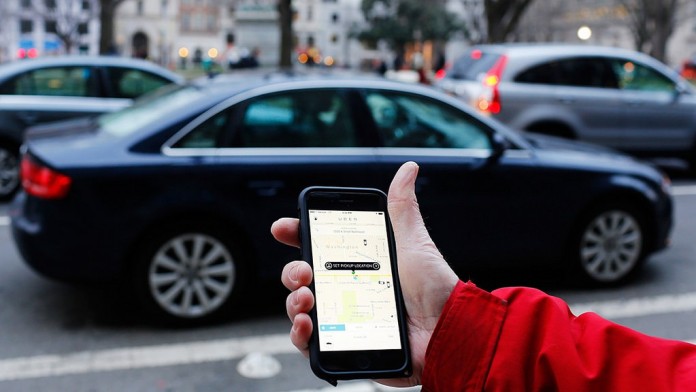
The New York City Council on Wednesday passed a cap on Uber, Lyft and other for-hire vehicles in the city along with a minimum wage for drivers, becoming the first city in the nation to impose such sweeping measures to offset the growth of the ride-hailing industry.
The legislation imposes a one-year ceiling on non-wheelchair-accessible for-hire vehicles while the city undertakes a study on the impacts of ride hailing. Uber and Lyft had objected to the proposal, arguing it would increase wait times and make rides harder to find in neighborhoods across the city.
In a statement, New York Mayor Bill De Blasio, D, commended the council for its vote, arguing the cap would “stop the influx of cars contributing to the congestion grinding our streets to a halt.” De Blasio called the growth of ride-hailing a “crisis” and said the services are clogging streets and “driving New Yorkers into poverty.” He said he intends to sign the bill.
The City Council also agreed to impose a minimum wage for ride-hail drivers recommended by a recent study commissioned by the city’s Taxi and Limousine Commission. The study recommended a $17.22 hourly minimum wage after expenses, arguing the measure would cover the costs of owning and driving a car in the city and allow for paid time off. City officials would set the wage.
Uber was fiercely opposed to the freeze in part because ride-hailing companies rely on a business model aimed at maximizing the number of available vehicles in an effort to reduce wait times for passengers.
“The City’s 12-month pause on new vehicle licenses will threaten one of the few reliable transportation options while doing nothing to fix the subways or ease congestion,” the company said in a statement.
Uber spokesman Josh Gold said in an interview Wednesday that the company will shift its strategy from opposing efforts to freeze the number of vehicles, to gobbling up the outstanding for-hire vehicle licenses available under the new cap. Ride-hailing services have an estimated 80,000 of the 120,000 available for-hire vehicle licenses in New York, the companies say.
Gold said the outstanding 40,000 licenses belong to black car and livery drivers, workers Uber will aim to recruit. The council’s newly imposed minimum wage will assist the company in those efforts, he said.
“We’re going to aggressively go after the 40,000 existing [for-hire vehicle] licenses to add to the 80,000 that we already dispatch to,” Gold said.
In a statement, Lyft decried the measure’s passage – arguing the cap would make hailing a ride more difficult across the city, particularly in less dense areas.
“These sweeping cuts to transportation will bring New Yorkers back to an era of struggling to get a ride, particularly for communities of color and in the outer boroughs,” said Joseph Okpaku, Lyft’s vice president of public policy.
The city’s measures follow mounting public pressure to confront the rise of the ride-hailing services, as taxi industry fortunes have fallen and workers have struggled to make a living. Six city taxi drivers have committed suicide in recent months under the financial pressure, according to the New York Taxi Workers Alliance.
The Independent Drivers Guild, a labor group representing more than 60,000 app-based professional drivers in the city, said the wage floor was the culmination of a two-year battle aimed at eliminating what is described as a loophole that allowed Uber and Lyft to subvert minimum wage requirements by classifying drivers as contractors.
“More than 65,000 working families will be getting a desperately needed raise because of today’s vote. We hope this is the start of a more fair industry not only here in New York City, but all over the world,” the labor group’s founder, Jim Conigliaro Jr., said in a statement. “We cannot allow the so-called ‘gig economy’ companies to exploit loopholes in the law in order to strip workers of their rights and protections.”
The guild says nine in 10 of its members drive for ride-hailing companies as their primary source of income, underscoring the need for a minimum wage.
City planners have argued in favor of measures to curb the growth of app-based services, which is most acute in city centers. Officials have pushed for congestion-based pricing and measures such as ride-hailing revenue taxes – that aim to capitalize on the growth of ride-hailing to supplement public transit. Uber and Lyft support congestion-based road pricing in part because it targets all private vehicles, rather than singling out ride-sharing.
Uber and Lyft contend they reduce users’ dependence on private vehicles and complement public transit. But studies have shown Uber increases traffic congestion in major urban areas, including Manhattan, in part by pulling from more sustainable modes.
(c) 2018, The Washington Post · Faiz Siddiqui
{Matzav.com}











